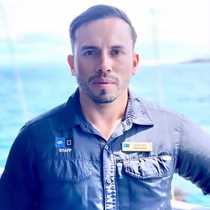Isabela & Fernandina Island
Today we decided to explore the wonders of the northwest side of Isabela Island, the largest of all the islands in the Archipelago. After crossing the equator, we went out for a Zodiac ride along the titanic cliffs, cracked by geological features like dikes and sills. The visitor site here is known as Punta Vicente Roca, a place full of surprises, as you never know what this very productive side of the Galápagos can offer.
We certainly got surprised by a pod of four orcas, performing quite a friendly show for us, allowing us to see the beautiful patterns of these black and white titans of the ocean. These amazing creatures stayed next to us for quite a while. I personally enjoyed the show the show with a great feeling of pride and value for the islands where I grew up; these are the type of wonders that bring unforgettable moments to my soul.
TheZodiac ride along the coast was getting better and better each time, as the ocean sunfish displayed a very unique journey, going side to side with his dorsal fin; we have to mention that this is one of the largest boned fish in the world. The upwelling cells of the Galápagos cover a very extensive area of Isabela, making these waters very productive for marine life; most of the 22 percent of endemic life of the islands is found around these waters. Some flightless cormorants, penguins and fur sea lions were also spotted on the coast of the island, sitting before a very interesting background of rusty lava and compacted ash.
We could not leave this place without exploring the underwater world and its wonders. This is one of most delightful places in the archipelago to snorkel; the Pacific green sea turtles are plenty in numbers in this area, and we snorkeled with many of them surrounding us. This is a place like no other, with one-of-a-kind experiences, making us feel as though we belong to this underwater world where the animals are so habituated to the human presence.
Another jewel in the crown was explored during the afternoon outing: Fernandina Island, the youngest and most preserved of all. We had a trip going back in time, to show us how the Galápagos was before the human presence. No introduced animals were found on this island for hundreds of thousands of years, until some records were found in the last five years.
The pristine beginning of endemic and native life can be felt here— pioneer species like the endemic species of lava cacti; very adapted species of native mangroves; some snakes found only here; and of course we couldn’t miss them, as plenty they were: the largest of the Galápagos marine iguanas.
The young mother volcano on Fernandina gives you the perfect picture of the wild action it takes for impressive islands like the Galápagos to be created.




